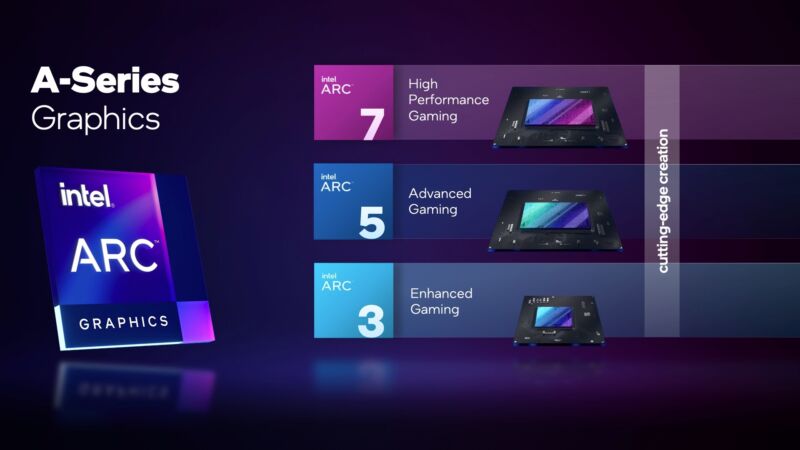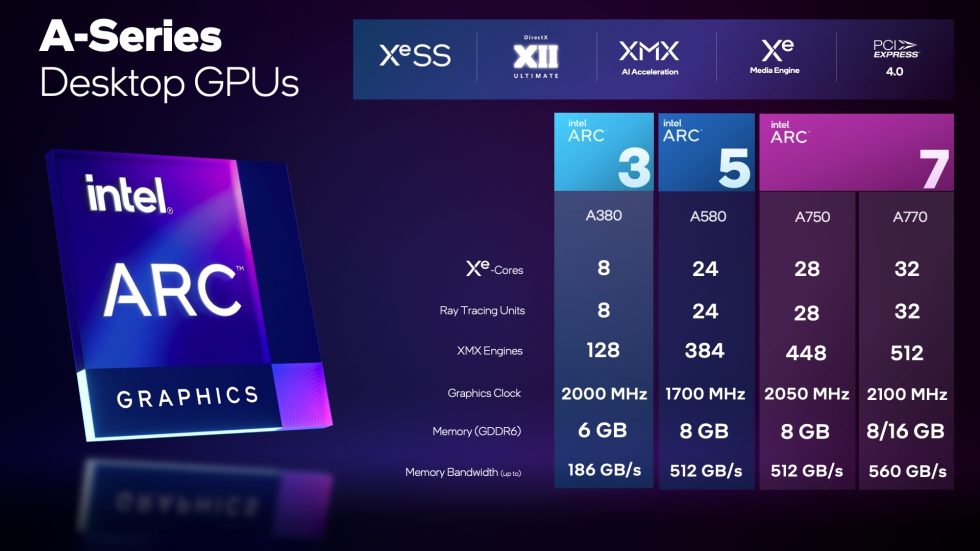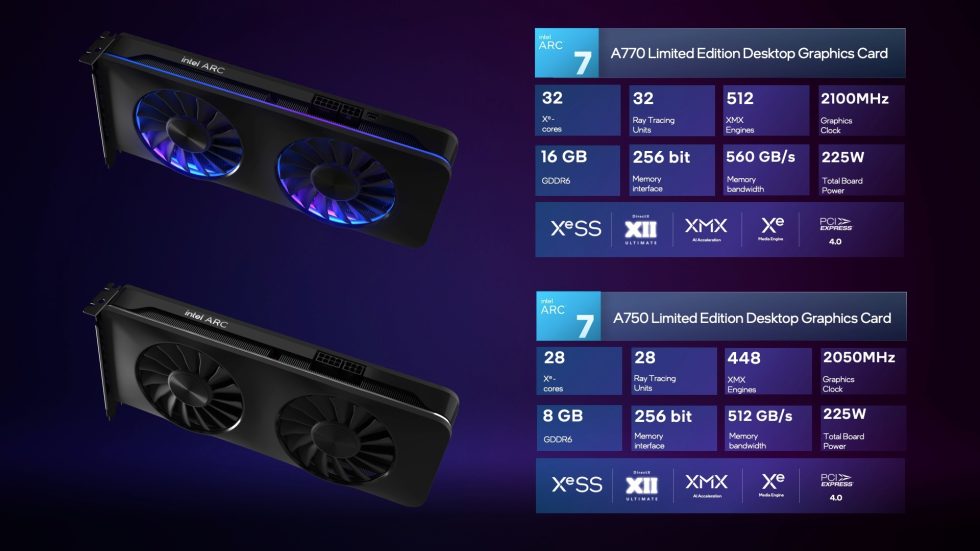
Intel's GPU performance tiers. The gap between 3 and 5 is much larger than the gap between 5 and 7.
Intel’s slow, steady drip of information about its upcoming Arc GPUs continued last week when the company released the final specs for its four A-series desktop graphics cards. As with the laptop GPUs the company announced earlier this year, the desktop Arc cards are split between the entry-level Arc 3, midrange Arc 5, and high-end Arc 7 tiers.
The only Arc GPU that has been extensively vetted by independent testers is the entry-level A380, which is also the only one that has had any kind of official launch in the US (this back-ordered $140 ASRock Challenger model listed on Newegg, not counting more expensive cards imported from China). It's by far the weakest GPU in the lineup, with just eight of Intel's Xe cores and ray tracing units and 6GB of GDDR6 memory on a 96-bit memory bus. Reviews usually show the A380 trading blows with older and budget-focused GPUs like Nvidia's GTX 1650 or AMD's RX 6400, depending on the game.

The other three GPUs are all a lot more similar. The A580, A750, and A770 have 24, 28, and 32 Xe cores, respectively, all increasing in clock speed as you climb upward. But they all share a 256-bit memory bus and 8GB of GDDR6 RAM (with a 16GB option available for the A770). Intel showed off its own "Limited Edition" first-party versions of the A770 and A750; they share the same basic board and fan design and 225 W board power, but the A770 has built-in LEDs, and the A750 doesn't. Intel is presumably leaving the lower-end A580 and A380 cards to its board partners, rather than making its own versions.
Intel's tests show the A750 GPU competing with the Nvidia RTX 3060 in DirectX12 and Vulkan games; going purely from the on-paper specs, this suggests that the A770 will land somewhere between an RTX 3060 and 3070, while the A580 will perform worse than a 3060 but better than a 3050.
This is a pretty narrow range of performance, with a big gap between the low-end and the midrange cards and no offering at all for high-end gaming PCs, but it makes sense given that the Alchemist family is supposedly based on a pair of GPU dies, with one maxing out at eight Xe cores (the A380) and the other at 32 Xe cores (with the 28- and 24-core versions being "binned" versions that shut off defective or underperforming cores so that the die itself can still be used). Nvidia and AMD's current GPU ranges usually use at least three or four different GPU dies.

Making performance comparisons with established Nvidia and AMD GPUs is difficult for Arc GPUs because of driver issues. The company acknowledged that performance in older DirectX11 games wouldn't be up to the same level as performance in games that use the low-overhead DirectX12 and Vulkan APIs, and the company is leaning on code translation for old DirectX9 games rather than allowing the GPUs to run those games natively. And Arc GPU performance suffers significantly if the Resizable BAR (also called ReBar or Smart Access Memory) feature isn't enabled or supported by your motherboard, making Arc GPUs a bad choice for upgrading an older PC.
Compounding Intel's launch issues, AMD and Nvidia are already gearing up for next-generation GPU launches. AMD briefly showed off an RDNA3-based GPU at its Ryzen 7000 announcement event last month, while Nvidia's RTX 4000-series GPUs are expected to be announced as early as next week. Intel’s next-gen Battlemage GPUs won’t be released until 2023 at the earliest, so these Alchemist GPUs will likely find themselves competing against RTX 4060-series and RX 7600-series GPUs soon enough.
Intel has said that it will be pricing Arc GPUs based on its DirectX11 game performance, making its cards more appealing for bargain hunters wanting to put together an inexpensive-but-capable gaming PC. The company just needs to launch them first.
Listing image by Intel


3175x175(CURRENT).thumb.jpg.b05acc060982b36f5891ba728e6d953c.jpg)
Recommended Comments
There are no comments to display.
Join the conversation
You can post now and register later. If you have an account, sign in now to post with your account.
Note: Your post will require moderator approval before it will be visible.